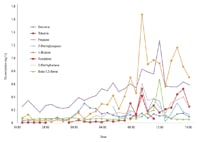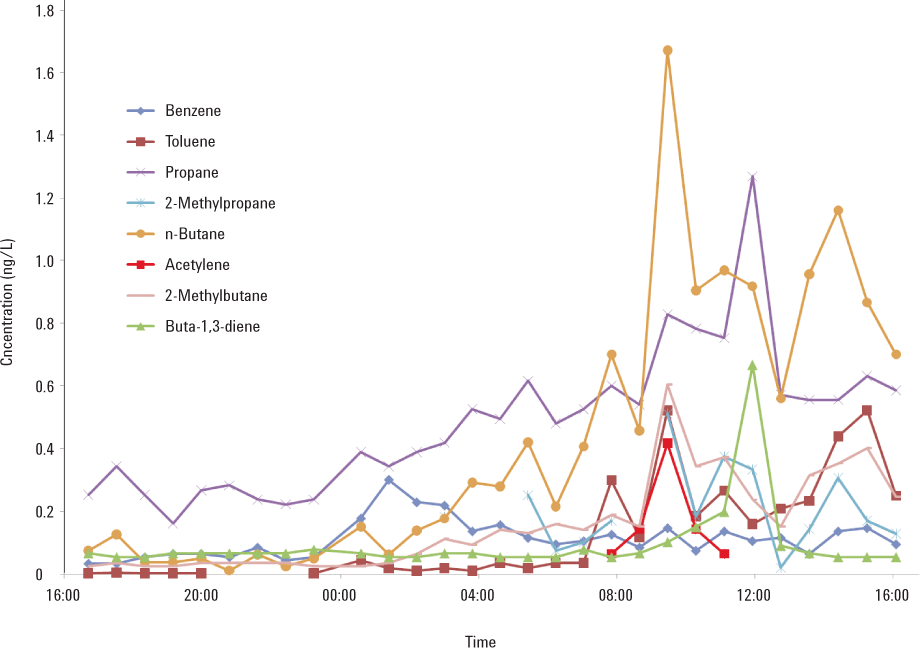Access Agilent eNewsletter, October 2013
>> Update My Profile | Subscribe to Access Agilent | Article Directory

New integrated solution reliably measures air toxins
By Laura Provoost
Agilent GC Product Manager
Air pollution is an issue of major concern worldwide. Pollutants in the air can be encountered both indoor and out. These toxic particulates are found in everything from vehicle exhaust to cooking fires… forest fire smoke to volcanic eruption vapor, as well as volatiles and semivolatiles from industrial processes. The challenge for analysts is to gather uniform samples and execute multiple testing methods seamlessly on an ongoing basis.
To provide analysts with a robust solution – that enables autosampling, reduces gas and energy use, and simultaneously analyzes volatiles and semivolitiles – we combined the capabilities of the Agilent 7890B GC system and Agilent 5977A Series GC/MSD with the Markes UNITY thermal desorption (TD) system. The Markes UNITY TD captures organic pollutants prior to injection – and when combined with the Agilent 7890B GC and 5977A MSD, provides a complete system for air sampling, desorption, and testing. It is an integrated solution enabling consistent sampling that conforms to standard methods and routinely achieves lower detection limits. In this article, we will discuss two applications to demonstrate how well it works.
 Enlarge
Enlarge
Figure 1. Diurnal profile of selected hydrocarbons, showing distinct differences between traffic-free and traffic-heavy periods.
Unattended round-the-clock air analysis
Volatile hydrocarbons in urban air could contribute to the production of ground-level ozone, one of the main constituents of smog. These compounds of interest are generally referred to as ozone precursors. Vehicle emissions are thought to be the main source of ozone precursors, which range in volatility from acetylene (ethyne) to trimethylbenzene and include benzene, toluene, xylene and buta-1,3-diene. European [1] and US regulations [2] require round-the-clock monitoring of target species in all major urban centers to assess possible links between periods of high traffic density and high pollution levels. This continuous real-time monitoring also provides an insight into industry emissions and can be used to monitor weather effects such as wind direction, rainfall, and temperature inversion.
To evaluate the combined system’s unattended performance in the field, we analyzed air quality from a forested semi-rural area that has high volumes of traffic during the working week and very few cars on weekends. Figure 1 shows a diurnal profile of various compounds from 4:40PM on a Sunday through Monday evening.
The difference between the traffic-free and peak periods was distinct. Most of the hydrocarbons were at low levels during the traffic-free periods, with rapid increases during peak commuting hours. Importantly, the system ran unattended with no intervention required during the trial, while detection limits – even in this relatively clean environment – were also satisfactory.
 Enlarge
Enlarge
Figure 2. Chromatograms of air samples from office, laboratory, and outside were collected using “Universal” sorbent tubes and desorbed splitless.
EPA Method TO-17 for monitoring air toxins
We collected office, laboratory, and semi-rural outside air samples onto Markes ‘Universal’ sorbent tubes. The sample flow rate was 50 mL/min for 20 minutes, giving a total volume of 1 L in each case. We then analyzed each sample tube splitless using a full-scan MS method from 10 to 300 amu. The data are shown in Figure 2. Semivolatiles that were not seen in the laboratory or outside air samples were evident in the office sample, presumably outgassed from soft furnishings.
Trust our combined solution for consistently accurate air analysis.
Government and industry laboratory chromatographers who want reliable, accurate, and consistent air pollution testing of volatiles and semivolatiles can rely on the Agilent 5977/7890B Series GC/MSD and Markes Unity Series 2 TD integrated system. Take time now to learn more about the many benefits of Agilent’s air analysis solutions, and order your copy of our new Air Monitoring Poster (5991-2380EN).
Acknowledgment
We thank Markes International Ltd for use of the chromatograms and supporting text.
References
- EC directives 96/62/EC (1996) and 2000/69/EC (2000). http://ec.europa.eu/environment/air/legis.htm
- US Clean Air Act Amendments (1990). http://www.epa.gov/air/caa/
>> Update My Profile | Subscribe to Access Agilent | Article Directory
Figure 1.

Conditions |
|
|---|---|
Column |
Agilent J&W GS-GasPro, 30 m x 0.32 mm, 4 µm (p/n CP8568) |
GC program |
40 °C (hold 6 min) then 20 °C/min to 200 °C (hold 1 min) |
UNITY 2 parameters |
|
|---|---|
Prepurge time |
1 min |
Sampling rate |
25 mL/min |
Sampling time |
Various |
Cold trap |
U-T17O3P-2S (ozone precursor) |
Cold trap low |
–30 °C |
Cold trap high |
325 °C |
Cold trap hold |
5 min |
Flow path temp. |
80 °C |
Diurnal profile of selected hydrocarbons, showing distinct differences between traffic-free and traffic-heavy periods.
Figure 2.

Conditions |
|
|---|---|
Column |
Agilent J&W DB-624, 60 m x 0.32 mm, 1.80 µm (p/n 123-1364) |
Carrier gas |
He |
Constant pressure mode |
10 psi |
Temp. program |
35°C (5 min), 5 °C/min to 230 °C (0 min) |
MS source temp |
230 °C |
MS quadrupole temp |
150 °C |
MSD transfer line temp |
200 °C |
Full scan mode mass range |
35 to 300 amu |
UNITY 2 parameters |
|
|---|---|
Cold Trap |
Markes Air Toxic Analyzer/Soil Gas trap (p/n U-T15ATA-2S) |
Tubes |
Markes Air Toxic Analysis tubes (p/n C2-AXXX-5270) |
Cold trap low temp |
25 °C |
Tube desorption temp |
320 °C |
Tube desorption time |
10 min |
Trap purge time |
2.0 min |
Cold trap high temp |
320 °C for 3 min |
Split ratio |
splitless or 10:1 outlet split |
Trap heating rate |
40 °C/s |
TD flow path |
140 °C |
Peak ID
- Methanol
- 2-Methyl butane
- Ethanol
- Acetone
- Isopropyl alcohol
- 2-Methyl pentane
- 3-Methyl pentane
- Hexane
- Ethyl acetate
- 2-Methyl hexane
- Cyclohexane
- 3-Methyl hexane
- Heptane
- Acetic acid
- 1-Methy-2-propanol
- Toluene
- Hexanal
- Xylene
- Xylene
- Alpha-pinene
- Cyclohexanone
- Alpha-myrcene
- D-limonene
- Phenol
- Menthol
- 2-Phenoxy ethanol
Chromatograms of air samples from office, laboratory, and outside were collected using “Universal” sorbent tubes and desorbed splitless.